OSH Performance within TQM Application in Construction Companies: A Qualitative Study in Saudi Arabia
Abstract
:1. Introduction
2. Materials and Methods
3. Results
4. Discussion
4.1. Influenced Social Factors
4.1.1. Enhanced Workforce Safety and Improved Management Pledges toward OSH
4.1.2. Developed Training and Improved Relationships between Management and Workforces
4.1.3. Improved Workforce Participation and Developed Health Insurance
4.2. Influenced Environmental Factors
4.2.1. Developed Work Culture toward OSH
4.2.2. Secured Working Environment
4.2.3. Enhanced Personal Protective Equipment and Planned/Controlled Hazards and Risks
4.3. Influenced Economic Factors
4.3.1. Controlled Occupational Injuries
4.3.2. Controlled Occupational Diseases and Improved Supervision and Inspection
4.3.3. Reduced Occupational Injury Costs
5. Conclusions
Author Contributions
Funding
Institutional Review Board Statement
Informed Consent Statement
Data Availability Statement
Conflicts of Interest
Appendix A
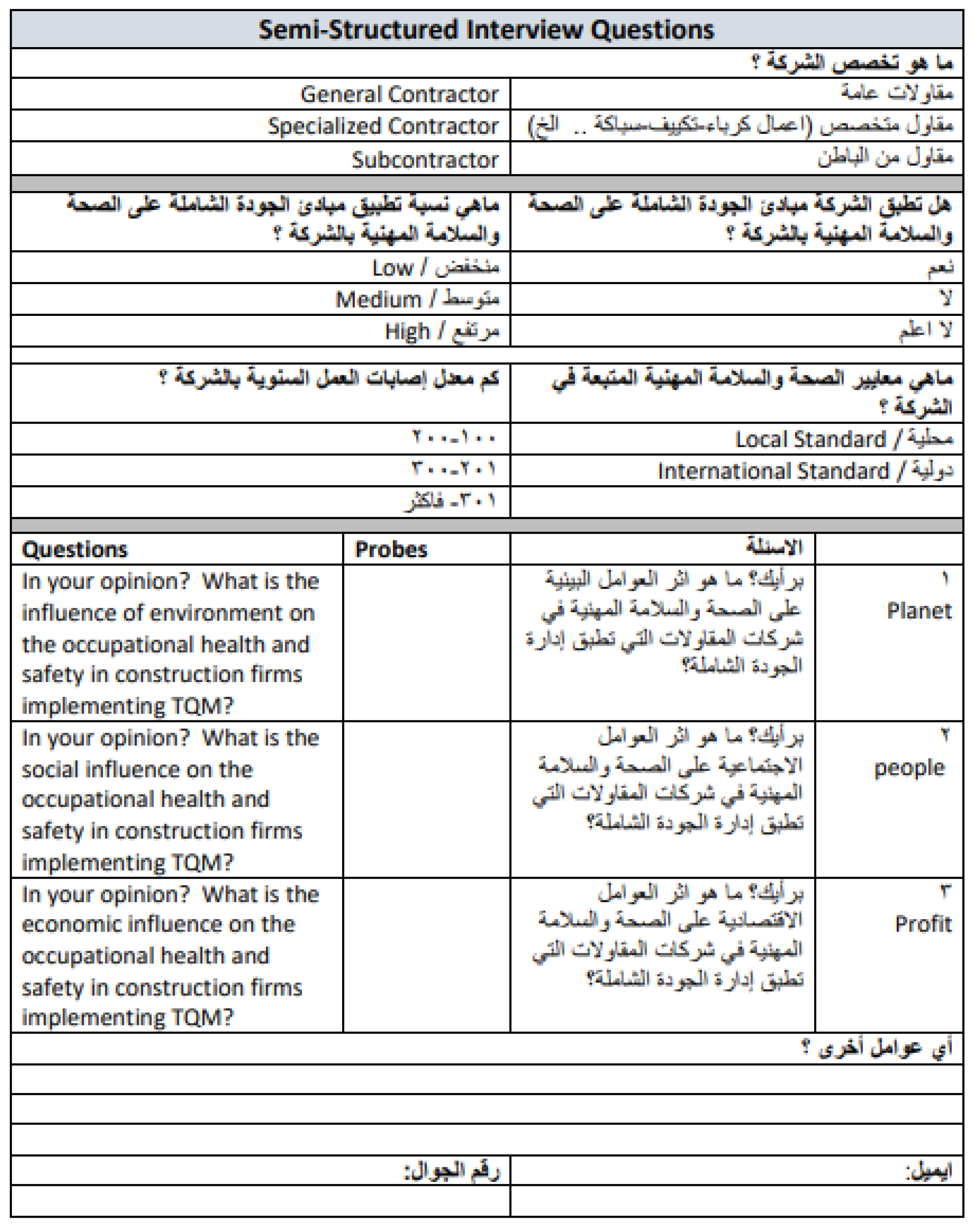
References
- Alrashed, I.; Alrashed, A.; Taj, S.; Phillips, M.; Kantamaneni, K. Risk assessment for construction projects in Saudi Arabia. Res. J. Manag. Sci. 2014, 3, 1–6. [Google Scholar]
- Al-Sedairy, S.T. A change management model for Saudi construction industry. Int. J. Proj. Manag. 2001, 19, 161–169. [Google Scholar] [CrossRef]
- Suresh, S.; Renukappa, S.; Alghanmi, I.; Mushatat, S.; Olayinka, R. Examining the Satisfaction Level of Construction Workers Regarding Safety Management in the Kingdom of Saudi Arabia. J. Constr. Dev. Ctries. 2017, 22, 97–113. [Google Scholar] [CrossRef]
- Wu, X.; Liu, Q.; Zhang, L.; Skibniewski, M.J.; Wang, Y. Prospective Safety Performance Evaluation on Construction Sites. Accid. Anal. Prev. 2015, 78, 58–72. [Google Scholar] [CrossRef]
- Meliá, J.L.; Mearns, K.; Silva, S.A.; Lima, M.L. Safety Climate Responses and the Perceived Risk of Accidents in the Construction Industry. Saf. Sci. 2008, 46, 949–958. [Google Scholar] [CrossRef]
- Mosly, I. Factors Influencing Safety Climate in the Construction Industry: A Review. Int. J. Constr. Eng. Manag. 2019, 8, 105–109. [Google Scholar] [CrossRef]
- Sunindijo, R.; Zou, P. How project manager’s skills may influence the development of safety climate in construction projects. Int. J. Proj. Organ. Manag. 2012, 4, 286–301. [Google Scholar] [CrossRef]
- Saudi Contracting Authority (SCA), Injuries Statistics, Muqawil. Muqawil.org. Available online: https://muqawil.org/ar/newinformationcenter/statistics (accessed on 11 January 2022).
- Pandit, B.; Albert, A.; Patil, Y.; Al-Bayati, A. Impact of safety climate on hazard recognition and safety risk perception. Saf. Sci. 2019, 113, 44–53. [Google Scholar] [CrossRef]
- Zhu, C.J.; Fan, D.; Fu, G.; Clissold, G. Occupational Safety in China: Safety Climate and Its Influence on Safety-Related Behavior. China Inf. 2010, 24, 27–59. [Google Scholar] [CrossRef]
- Klimecka-Tatar, D. Safety Management in Quality Management Approach-The Context of Safe Working Conditions in Micro-, Small and Medium-Sized and Large Enterprises. In Proceedings of the 35th IBIMA Conference, Seville, Spain, 1–2 April 2020; pp. 1–2. [Google Scholar]
- Kwan, L.S. Applying TQM principles in safety management: A study on the effectiveness of total safety management. Int. J. Bus. Soc. Sci. 2016, 7, 101–113. [Google Scholar]
- Deming, W.E. Out of the Crisis; Reprint Edition; The MIT Press: Cambridge, MA, USA, 2000. [Google Scholar]
- Guasch, J.L.; Racine, J.L.; Sanchez, I.; Diop, M. Quality Systems and Standards for a Competitive Edge; World Bank Publications: Herndon, VA, USA, 2007. [Google Scholar]
- ASQ. History & Evolution of Total Quality Management (TQM). Learn About Quality. Available online: https://asq.org/quality-resources/total-quality-management/tqm-history (accessed on 24 December 2021).
- Bari, M.W.; Fanchen, M.; Baloch, M.A. TQM Soft Practices and Job Satisfaction; Mediating Role of Relational Psychological Contract. Procedia Soc. Behav. Sci. 2016, 235, 453–462. [Google Scholar] [CrossRef]
- Pheng, L.S.; Teo, J.A. Implementing total quality management in construction firms. J. Manag. Eng. 2004, 20, 8–15. [Google Scholar] [CrossRef]
- Panuwatwanich, K.; Nguyen, T.T. Influence of Total Quality Management on Performance of Vietnamese Construction Firms. Procedia Eng. 2017, 182, 548–555. [Google Scholar] [CrossRef]
- Haque, A.; Sarwar, A.; Azam, F.; Yasmin, F. Total Quality Management Practices in the Islamic Banking Industry: Comparison between Bangladesh and Malaysian Islamic Bank. Int. J. Ethics Soc. Sci. 2014, 2. Available online: http://www.crimbbd.org/wp-content/uploads/2014/07/2.1.pdf (accessed on 10 February 2022).
- Balon, B.; Roszak, M. Cost-Quantitative Analysis of Non-Compliance in the Internal Logistics Process. Prod. Eng. Arch. 2020, 26, 60–66. [Google Scholar] [CrossRef]
- Iqbal, A.; Asrar-ul-Haq, M. Establishing Relationship between TQM Practices and Employee Performance: The Mediating Role of Change Readiness. Int. J. Prod. Econ. 2018, 203, 62–68. [Google Scholar] [CrossRef]
- Amin, M.; Aldakhil, A.M.; Wu, C.; Rezaei, S.; Cobanoglu, C. The structural relationship between TQM, employee satisfaction and hotel performance. Int. J. Contemp. Hosp. Manag. 2017, 29, 1256–1278. [Google Scholar] [CrossRef]
- Goetsch, D.; Davis, S. Quality Management for Organizational Excellence: Introduction to Total Quality, 8th ed.; Pearson: Boston, MA, USA, 2015. [Google Scholar]
- Vouzas, F.K.; Gotzamani, K.D. Best Practices of Selected Greek Organizations on Their Road to Business Excellence: The Contribution of the New ISO 9000:2000 Series of Standards. TQM Mag. 2005, 17, 259–266. [Google Scholar] [CrossRef]
- Vouzas, F.; Psychogios, A.G. Assessing Managers’ Awareness of TQM. TQM Mag. 2007, 19, 62–75. [Google Scholar] [CrossRef]
- Fotopoulos, C.B.; Psomas, E.L. The Impact of “Soft” and “Hard” TQM Elements on Quality Management Results. Int. J. Qual. Reliab. Manag. 2009, 26, 150–163. [Google Scholar] [CrossRef]
- Klimecka-Tatar, D.; Matevž, O. The Level of Occupational Health and Safety in European Enterprises Providing Transport and Logistics Services in Terms of Quality Management Principles. Multidiscip. Asp. Prod. Eng. 2020, 3, 394–404. [Google Scholar] [CrossRef]
- Molamohamadi, Z. The Relationship between Occupational Safety, Health, and Environment, and Sustainable Development: A Review and Critique. Int. J. Innov. Manag. Technol. 2014, 5, 198. [Google Scholar] [CrossRef]
- Dibrell, C.; Craig, J.B.; Kim, J.; Johnson, A.J. Establishing How Natural Environmental Competency, Organizational Social Consciousness, and Innovativeness Relate. J. Bus. Ethics 2015, 127, 591–605. [Google Scholar] [CrossRef]
- Amponsah-Tawiah, K. Occupational Health and Safety and Sustainable Development in Ghana. Int. J. Bus. Adm. 2013, 4, 74–78. [Google Scholar] [CrossRef]
- Chong, H.-Y.; Lee, C.-Y.; Wang, X. A Mixed Review of the Adoption of Building Information Modelling (BIM) for Sustainability. J. Clean. Prod. 2017, 142, 4114–4126. [Google Scholar] [CrossRef]
- Oladazimi, A.; Mansour, S.; Hosseinijou, S.; Majdfaghihi, M. Sustainability Identification of Steel and Concrete Construction Frames with Respect to Triple Bottom Line. Buildings 2021, 11, 565. [Google Scholar] [CrossRef]
- Svensson, G.; Wagner, B. Implementing and Managing Economic, Social and Environmental Efforts of Business Sustainability: Propositions for Measurement and Structural Models. Manage. Environ. Qual. 2015, 26, 195–213. [Google Scholar] [CrossRef]
- Arowoshegbe, A.O.; Uniamikogbo, E. Sustainability and Triple Bottom Line: An Overview of Two Interrelated Concepts. Igbinedion Univ. J. Account. 2016, 2, 88–126. [Google Scholar]
- Alhaddi, H. Triple bottom line and sustainability: A literature review. Bus. Manag. Stud. 2015, 1, 6–10. [Google Scholar] [CrossRef]
- Schroeder, B.; Denoble, A. How to design a triple bottom line organization a start-up case study. J. Organ. Des. 2014, 3, 48–57. [Google Scholar] [CrossRef]
- Dalibozhko, A.; Krakovetskaya, I. Youth entrepreneurial projects for the sustainable development of global community: Evidence from Enactus program. In SHS Web of Conferences; EDP Sciences: Ulysse, France, 2018; Volume 57, p. 01009. [Google Scholar]
- Akanmu, M.D.; Hassan, M.G.; Mohamad, B.; Nordin, N. Sustainability through TQM Practices in the Food and Beverages Industry. Int. J. Qual. Reliab. Manag. 2021. ahead-of-print. [Google Scholar] [CrossRef]
- Ho, S.K. Global sustainable development through the integrated lean management (Green 5-S) model for TQM. Nang Yan Bus. J. 2012, 1, 27–37. [Google Scholar] [CrossRef]
- Elghamrawy, T.; Shibayama, T. Total Quality Management Implementation in the Egyptian construction. J. Manag. Eng. 2008, 24, 156–161. [Google Scholar] [CrossRef]
- Ministry of Human Resources and Social Development (MHRSD). Construction and Building Sector. Available online: https://sosh.hrsd.gov.sa/ar/Construction (accessed on 28 January 2022).
- Haadir, S.A.; Panuwatwanich, K. Critical Success Factors for Safety Program Implementation among Construction Companies in Saudi Arabia. Procedia Eng. 2011, 14, 148–155. [Google Scholar] [CrossRef] [Green Version]
- Khasawneh, A. Improving occupational health and workplace safety in Saudi Arabia. Int. J. Dev. Sust. 2014, 3, 261–267. [Google Scholar]
- Mosly, I.; Makki, A.A. Safety Climate Perceptions in the Construction Industry of Saudi Arabia: The Current Situation. Int. J. Environ. Res. Public Health 2020, 17, 6717. [Google Scholar] [CrossRef]
- Makki, A.A.; Mosly, I. Determinants for Safety Climate Evaluation of Construction Industry Sites in Saudi Arabia. Int. J. Environ. Res. Public Health 2020, 17, 8225. [Google Scholar] [CrossRef]
- Almasoud, M. Study on How to Established National Occupational Health and Safety at Institute in Saudi Arabia. New Vis. Sci. Technol. 2021, 2, 110–115. [Google Scholar]
- Sanni-Anibire, M.O.; Mahmoud, A.S.; Hassanain, M.A.; Almutairi, F. Health and safety perception of construction workers in Saudi Arabia. Archit. Civ. Eng. Environ. 2018, 11, 107–118. [Google Scholar] [CrossRef]
- Erogul, M.S.; Alyami, M.M. Construction site safety in small construction companies in Saudi Arabia. Int. J. Manag. Pract. 2017, 10, 406–421. [Google Scholar] [CrossRef]
- Moosa, M.M.; Oriet, L.P.; Khamaj, A.M. Measuring the Causes of Saudi Arabian Construction Accidents: Management and Concerns. Int. J. Occup. Saf. Health 2020, 10, 108–114. [Google Scholar] [CrossRef]
- Ministry of Municipal Rural Affairs and Housing (MOMRAH). 15 July 2021. Classification Point Program. Available online: https://balady.gov.sa/Services/DownloadUserGuide/294 (accessed on 10 February 2022).
- Ministry of Municipal Rural Affairs and Housing (MOMRAH). 24 February 2018. Sustainable Building. Sustainable Building Program. Available online: https://mostadam.sa/sites/default/files/2021-06/20210608-mostadam-inspection-doc.pdf (accessed on 10 February 2022).
- Kvale, S. Ten standard objections to qualitative research interviews. J. Phenomenol. Psychol. 1994, 25, 147–173. [Google Scholar] [CrossRef]
- Kvale, S.; Brinkmann, S. Interviews: Learning the Craft of Qualitative Research Interviewing; Sage: Thousand Oaks, CA, USA, 2009. [Google Scholar]
- Srivastava, S.; Raniga, U.I.; Misra, S. A Methodological Framework for Life Cycle Sustainability Assessment of Construction Projects Incorporating TBL and Decoupling Principles. Sustainability 2021, 14, 197. [Google Scholar] [CrossRef]
- Walker, D.; Myrick, F. Grounded Theory: An Exploration of Process and Procedure. Qual. Health Res. 2006, 16, 547–559. [Google Scholar] [CrossRef]
- Eisenhardt, K.M.; Graebner, M.E. Theory building from cases: Opportunities and challenges. Acad. Manag. J. 2007, 50, 25–32. [Google Scholar] [CrossRef]
- Li, Q.; Ji, C.; Yuan, J.; Han, R. Developing Dimensions and Key Indicators for the Safety Climate within China’s Construction Teams: A Questionnaire Survey on Construction Sites in Nanjing. Saf. Sci. 2017, 93, 266–276. [Google Scholar] [CrossRef]
- Psomas, E.L.; Jaca, C. The Impact of Total Quality Management on Service Company Performance: Evidence from Spain. Int. J. Qual. Reliab. Manag. 2016, 33, 380–398. [Google Scholar] [CrossRef]
- Milijic, N.; Mihajlovic, I.; Strbac, N.; Zivkovic, Z. Developing a Questionnaire for Measuring Safety Climate in the Workplace in Serbia. Int. J. Occup. Saf. Ergon. 2013, 19, 631–645. [Google Scholar] [CrossRef]
- Durdyev, S.; Mohamed, S.; Lay, M.L.; Ismail, S. Key Factors Affecting Construction Safety Performance in Developing Countries: Evidence from Cambodia. Constr. Econ. Build. 2017, 17, 48–65. [Google Scholar] [CrossRef]
- Zahoor, H.; Chan, A.P.C.; Masood, R.; Choudhry, R.M.; Javed, A.A.; Utama, W.P. Occupational Safety and Health Performance in the Pakistani Construction Industry: Stakeholders’ Perspective. Int. J. Constr. Manag. 2016, 16, 209–219. [Google Scholar] [CrossRef]
- Prajogo, D.I.; Cooper, B. The individual and organizational level effects of TQM practices on job satisfaction. Int. J. Manpow. 2017, 38, 215–225. [Google Scholar] [CrossRef]
- Malinda, A.; Soediantono, D. Benefits of Implementing ISO 45001 Occupational Health and Safety Management Systems and Implementation Suggestion in the Defense Industry: A Literature Review. J. Ind. Eng. Manag. Res. 2022, 3, 35–47. [Google Scholar] [CrossRef]
- Nawaz, A.; Su, X.; Din, Q.M.U.; Khalid, M.I.; Bilal, M.; Shah, S.A.R. Identification of the H&S (Health and Safety Factors) Involved in Infrastructure Projects in Developing Countries-A Sequential Mixed Method Approach of OLMT-Project. Int. J. Environ. Res. Public Health 2020, 17, 635. [Google Scholar] [CrossRef]
- Fang, D.; Chen, Y.; Wong, L. Safety Climate in Construction Industry: A Case Study in Hong Kong. J. Constr. Eng. Manag. 2006, 132, 573–584. [Google Scholar] [CrossRef]
- Ngwama, J.C. Framework for occupational health and safety in Nigeria: The implication for the trade union movement. J. Econ. Sustain. Dev. 2016, 7. [Google Scholar]
- Morgado, L.; Silva, F.J.G.; Fonseca, L.M. Mapping Occupational Health and Safety Management Systems in Portugal: Outlook for ISO 45001:2018 Adoption. Procedia Manuf. 2019, 38, 755–764. [Google Scholar] [CrossRef]
- Endroyo, B.; Suraji, A.; Besari, M.S. Model of the Maturity of Pre-Construction Safety Planning. Procedia Eng. 2017, 171, 413–418. [Google Scholar] [CrossRef]
- Terwel, K.; Vambersky, J. Possible critical structural safety factors: A literature review. In Proceedings of the 6th Congress on Forensic Engineering, San Francisco, CA, USA, 31 October–3 November 2012. [Google Scholar] [CrossRef]
- Weissbrodt, R.; Giauque, D. Labour Inspections and the Prevention of Psychosocial Risks at Work: A Realist Synthesis. Saf. Sci. 2017, 100, 110–124. [Google Scholar] [CrossRef] [Green Version]
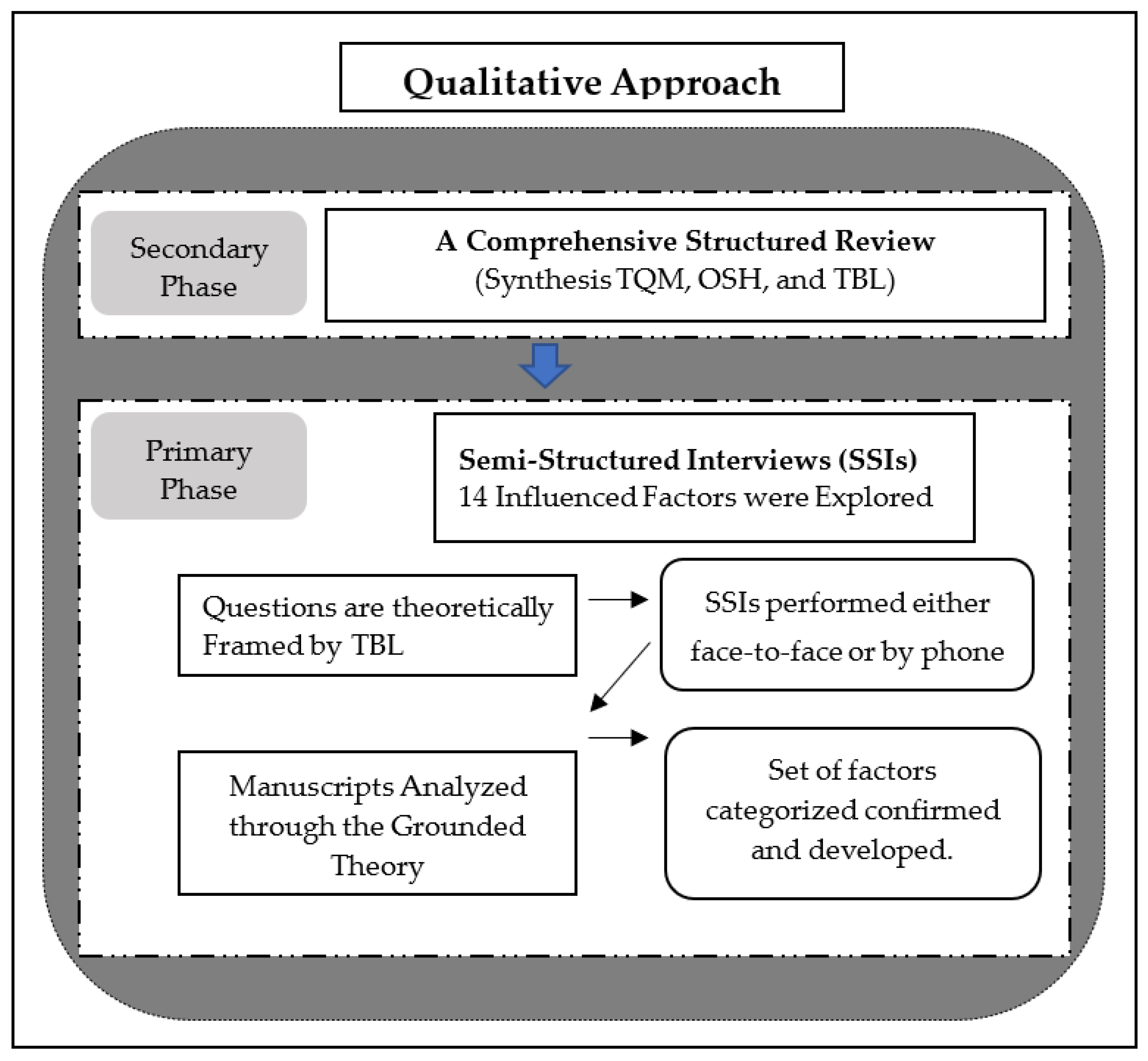

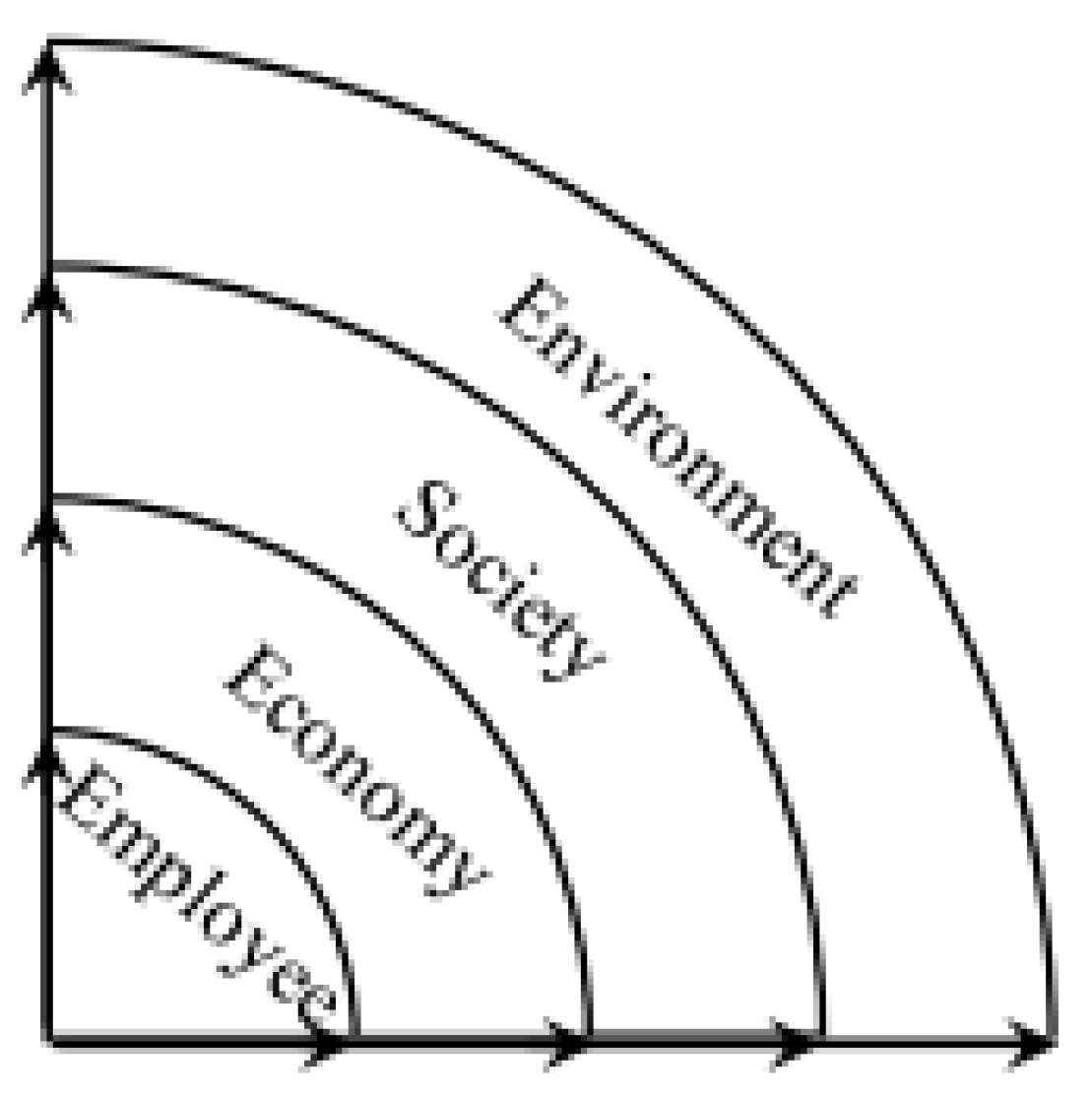

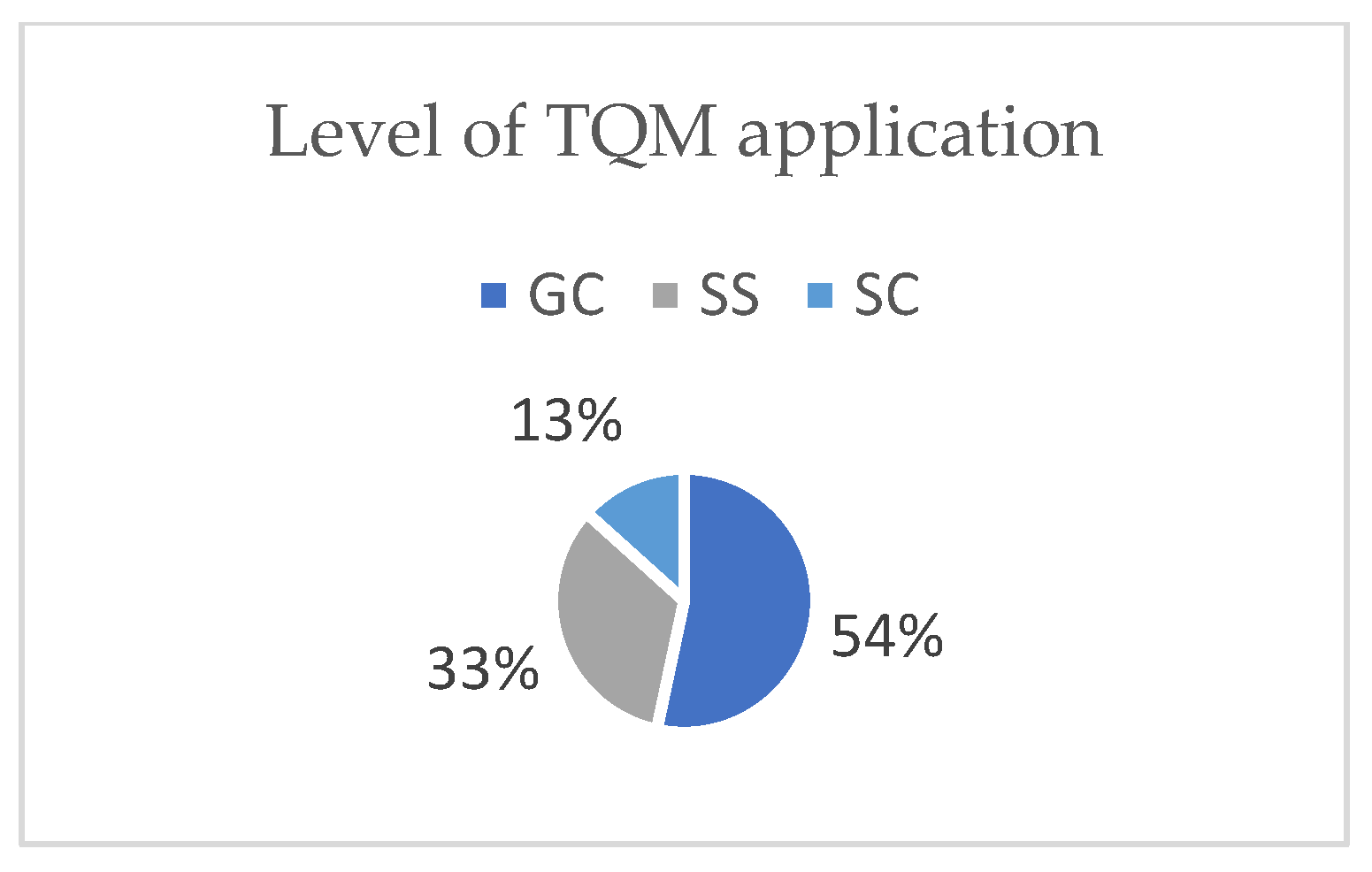
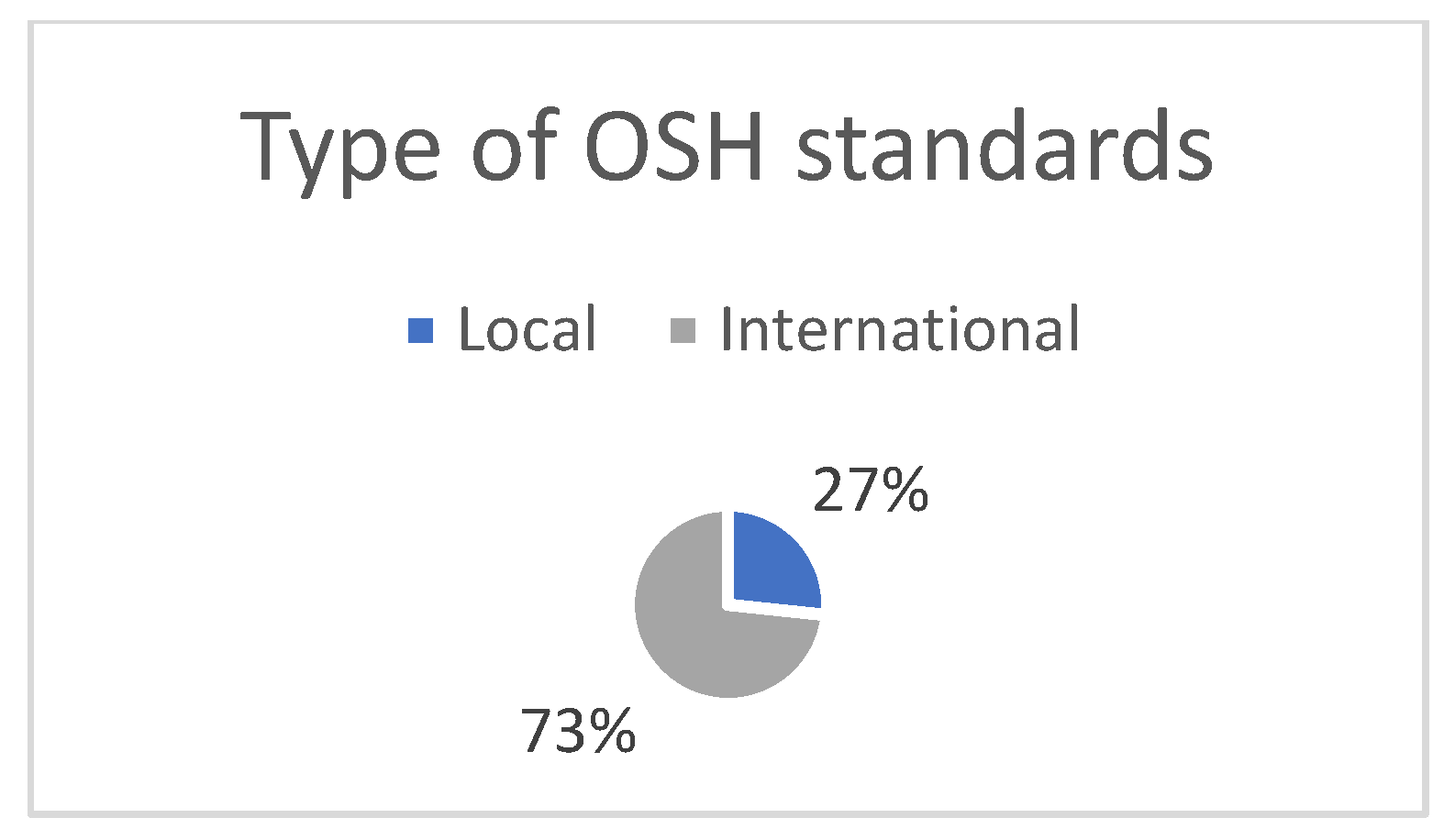


| Distribution of Number by Injury Status | Years | ||||
|---|---|---|---|---|---|
| 2016 | 2017 | 2018 | 2019 | 2020 | |
| Under Treatment | 4250 | 3969 | 2811 | 2688 | 3581 |
| Cured | 816 | 777 | 676 | 1134 | 69 |
| Disability | 489 | 513 | 461 | 180 | 27 |
| Death | 159 | 101 | 91 | 28 | 9 |
| TOTAL | 5714 | 5360 | 4039 | 4030 | 3686 |
| Distribution of Number by Company Size | Years | ||||
|---|---|---|---|---|---|
| 2016 | 2017 | 2018 | 2019 | 2020 | |
| Large | 4250 | 3969 | 2811 | 2688 | 2080 |
| Medium | 816 | 777 | 676 | 1134 | 914 |
| Small | 648 | 614 | 552 | 208 | 692 |
| TOTAL | 5714 | 5360 | 4039 | 4030 | 3686 |
| Principles of Quality Management | Principles in the Context of Occupational Safety and Health Management | |
|---|---|---|
| PRINCIPLE 1 | Customer orientation | Focus on employee safety—putting employee needs above economic, efficiency, and productivity conditions |
| PRINCIPLE 2 | Leadership | Being a role model in the aspect of care for work safety |
| PRINCIPLE 3 | Employee involvement | Employee involvement in the implementation of the mission, vision and goals of safe working conditions |
| PRINCIPLE 4 | Process approach | Documenting the inter-relationships of processes aimed at maintaining safety |
| PRINCIPLE 5 | System approach to quality management | System approach to safety management |
| PRINCIPLE 6 | Continuous improvement | Introducing additional safety systems, conducting regular training, etc. |
| PRINCIPLE 7 | Determining decisions based on facts | Legal documents, statistics, and results of monitoring security parameters |
| PRINCIPLE 8 | Mutual beneficial relationships with suppliers | Not applicable |
| Interviewee Identifier | Type | Interviewee Title | Location | Interview Type | Duration | |
|---|---|---|---|---|---|---|
| General Contractors | HD | CE | QM Director | Riyadh | Phone | 00:38:23 |
| MS | EE | QM Director | Riyadh | Office | 00:59:31 | |
| NA | ME | QM Senior Manager | Jeddah | Phone | 00:47:32 | |
| AH | CE | QM Site Engineer | Riyadh | On Site | 01:03:39 | |
| MA | CE | QM Site Engineer | Riyadh | On Site | 01:13:16 | |
| MK | ME | QM Manager | Riyadh | Office | 00:48:57 | |
| WA | EE | QM Senior Manager | Dammam | Phone | 00:43:11 | |
| Specialized Sub. | HA | ME | QM Div. Manager | Riyadh | Office | 00:59:16 |
| SK | ME | QM Div. Manager | Riyadh | Office | 00:56:08 | |
| AM | EE | QM Director | Riyadh | Phone | 00:47:23 | |
| SQ | CE | QM Director | Dammam | Phone | 00:36:58 | |
| Sub. | TA | EE | QM Site Engineer | Riyadh | On Site | 01:09:18 |
| MD | ME | QM Director | Jeddah | Phone | 00:38:14 | |
| MC | CE | QM Senior Manager | Riyadh | Office | 00:51:39 | |
| KK | EE | QM Director | Jeddah | Phone | 00:42:18 | |
| General Contractor (GC) | Specialized Subs. (SS) | Subcontractors ((SC) | |||||||||||||
|---|---|---|---|---|---|---|---|---|---|---|---|---|---|---|---|
| Participant specialty | CE | EE | ME | CE | CE | ME | EE | ME | ME | EE | CE | EE | ME | CE | EE |
| TQM experience | 17 | 22 | 18 | 20 | 21 | 19 | 17 | 14 | 10 | 10 | 12 | 11 | 13 | 10 | 12 |
| Scale of Importance | ||
|---|---|---|
| Low | Medium | High |
| X < 6.5% | 6.5% < X < 8.5% | X > 8.5% |
| Influenced OSH Factors | Thematic Factor | Freq. | Thematic Coding | Percentage | Scale |
|---|---|---|---|---|---|
| Social | Enhance workforce safety | 21 | EWSC | 9.8% | High |
| Improve management pledge toward OSH | 20 | IMPTO | 9.3% | High | |
| Develop training | 15 | DT | 7.0% | Medium | |
| Improve relationship between management and workforces | 14 | IRBMW | 6.5% | Medium | |
| Improve workforce participation | 11 | IWP | 5.1% | Low | |
| Develop health insurance | 10 | DHI | 4.7% | Low | |
| Environmental | Develop work culture toward OSH | 20 | DWCTO | 9.3% | High |
| Secure working environment | 15 | SWE | 7.0% | Medium | |
| Enhance personal protective equipment | 13 | EPPE | 6.1% | Low | |
| Plan and control hazards and risks | 12 | PCHR | 5.6% | Low | |
| Economical | Control occupational injuries | 22 | COI | 10.3% | High |
| Improve supervision and inspection | 18 | ISGI | 8.4% | Medium | |
| Control occupational diseases | 14 | COD | 6.5% | Medium | |
| Reduce occupational injuries costs | 9 | ROIC | 4.2% | Low | |
| Total | 214 |
| Principles of Total Quality Management | Link Finding Factors to TQM Principles | |
|---|---|---|
| PRINCIPLE 1 | Customer orientation | Soc.:1; Env.:2 |
| PRINCIPLE 2 | Leadership | Soc.:2; Env.:1 |
| PRINCIPLE 3 | Employee involvement | Soc.:5 |
| PRINCIPLE 4 | Process approach | Soc.:4; Eco.:1; Eco.:2 |
| PRINCIPLE 5 | System approach to quality management | Soc.:6; Env.:3 |
| PRINCIPLE 6 | Continuous improvement | Soc.:3; Eco.4 |
| PRINCIPLE 7 | Determining decisions based on facts | Env.:4; Eco:3 |
| PRINCIPLE 8 | Mutual beneficial relationships with suppliers | Not applicable |
Publisher’s Note: MDPI stays neutral with regard to jurisdictional claims in published maps and institutional affiliations. |
© 2022 by the authors. Licensee MDPI, Basel, Switzerland. This article is an open access article distributed under the terms and conditions of the Creative Commons Attribution (CC BY) license (https://creativecommons.org/licenses/by/4.0/).
Share and Cite
Alghaseb, M.; Alshmlani, T. OSH Performance within TQM Application in Construction Companies: A Qualitative Study in Saudi Arabia. Int. J. Environ. Res. Public Health 2022, 19, 12299. https://doi.org/10.3390/ijerph191912299
Alghaseb M, Alshmlani T. OSH Performance within TQM Application in Construction Companies: A Qualitative Study in Saudi Arabia. International Journal of Environmental Research and Public Health. 2022; 19(19):12299. https://doi.org/10.3390/ijerph191912299
Chicago/Turabian StyleAlghaseb, Mohammed, and Tariq Alshmlani. 2022. "OSH Performance within TQM Application in Construction Companies: A Qualitative Study in Saudi Arabia" International Journal of Environmental Research and Public Health 19, no. 19: 12299. https://doi.org/10.3390/ijerph191912299
APA StyleAlghaseb, M., & Alshmlani, T. (2022). OSH Performance within TQM Application in Construction Companies: A Qualitative Study in Saudi Arabia. International Journal of Environmental Research and Public Health, 19(19), 12299. https://doi.org/10.3390/ijerph191912299






